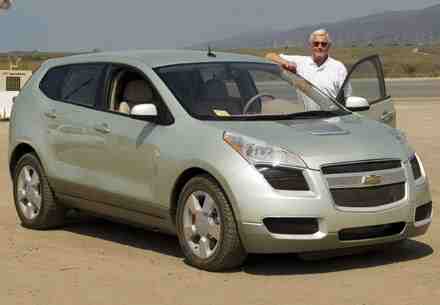 General Motors made history yesterday as its Chevy Sequel became the first electric fuel cell vehicle to achieve 300 miles on one tank of hydrogen, in and out of traffic on public roads, while producing zero emissions.
General Motors made history yesterday as its Chevy Sequel became the first electric fuel cell vehicle to achieve 300 miles on one tank of hydrogen, in and out of traffic on public roads, while producing zero emissions.
"With this drive, General Motors has reached an important milestone, said Larry Burns, GM vice president, research & development and strategic planning. "And we did it while producing zero emissions, as a hydrogen fuel cell vehicle only emits water."
The Chevrolet Sequel was introduced in 2005 at the North American International Auto Show in Detroit as the first vehicle in the world to successfully integrate a hydrogen fuel cell propulsion system. The first drivable version appeared last fall using lithium-ion batteries and a lightweight aluminum structure. It uses clean, renewable hydrogen as a fuel and emits only water vapor.
The 300-mile drive through the state of New York began at General Motors’ Fuel Cell Activity Center in Honeoye Falls, where the engineers who develop the company’s fuel cell technology officially sent the Sequel off into the history books. "It is our fuel cell teams’ dedication to this tremendously important cause," Burns said, "which will ultimately enable our country, and our world, to diversify our energy sources and displace large amounts of petroleum."
The Sequel achieved the 300-mile mark and crossed the finish line in Tarrytown, N.Y.
Last September GM promised to place a test fleet of 100 of its Chevrolet Equinox fuel cell vehicles with customers as part of a comprehensive deployment plan dubbed “Project Driveway." Beginning this fall, Project Driveway will begin gathering meaningful market data of fuel cell vehicles from consumers. A variety of drivers — in differing driving environments — will operate these vehicles and refuel with hydrogen in three geographic areas: California, the New York City area and Washington, D.C.




















Even though this is a very important feat, I think it is important to remain readers that Hydrogen is not an energy source, and must be created. In this case Chevy have used “renewable hydrogen” produced from some renewable energy source like “wind energy”. However, most hydrogen is produced with electricity that comes from normal (non renewable) power plants, therefore a hydrogen car in our present energy market would use more energy and pollute more than an efficient gasoline car of same size.